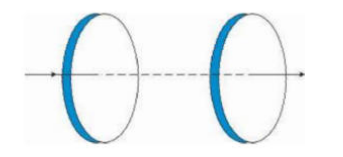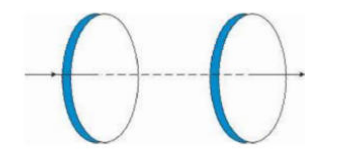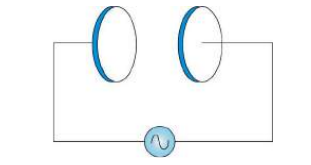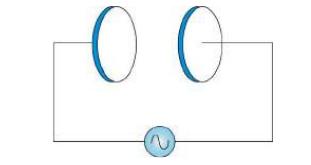Complete Solutions to EXERCISE of chapter ELECTROMAGNETIC WAVES of Class 12 book with complete answers and questions
| Class 12 | PHYSICS |
| Chapter | ELECTROMAGNETIC WAVES |
| PSEB | EXERCISE |
| Number Of Questions | 36 |
| Academic Year | 2023-24 |
Figure 8.6 shows a capacitor made of two circular plates each of radius 12 cm, and separated by 5.0 cm. The capacitor is being charged by an external source (not shown in the figure). The charging current is constant and equal to 0.15A. Calculate the capacitance and the rate of change of potential difference between the plates. :

View SolutionFigure shows a capacitor made of two circular plates each of radius 12 cm, and separated by 5.0 cm. The capacitor is being charged by an external source (not shown in the figure). The charging current is constant and equal to 0.15A. Obtain the displacement current across the plates. :

View SolutionFigure 8.6 shows a capacitor made of two circular plates each of radius 12 cm, and separated by 5.0 cm. The capacitor is being charged by an external source (not shown in the figure). The charging current is constant and equal to 0.15A. Is Kirchhoffs first rule (junction rule) valid at each plate of the capacitor? Explain. :

View SolutionA parallel plate capacitor (Fig. 8.7) made of circular plates each of radius R = 6.0 cm has a capacitance C = 100 pF. The capacitor is connected to a 230 V ac supply with a (angular) frequency of `300 rad s^-1`. What is the rms value of the conduction current? :

View SolutionA parallel plate capacitor (Fig. 8.7) made of circular plates each of radius R = 6.0 cm has a capacitance C = 100 pF. The capacitor is connected to a 230 V ac supply with a (angular) frequency of `300 rad s^-1`. Is the conduction current equal to the displacement current? :

View SolutionA parallel plate capacitor (Fig. 8.7) made of circular plates each of radius R = 6.0 cm has a capacitance C = 100 pF. The capacitor is connected to a 230 V ac supply with a (angular) frequency of `300 rad s^-1`. Determine the amplitude of B at a point 3.0 cm from the axis between the plates. :

View SolutionWhat physical quantity is the same for X-rays of wavelength `10^-10` m, red light of wavelength `6800 overset @A` and radiowaves of wavelength 500 m?
View SolutionA plane electromagnetic wave travels in vacuum along z-direction. What can you sayabout the directions of its electric and magnetic field vectors? If the frequency of the wave is 30 MHz, what is its wavelength?
View SolutionA radio can tune in to any station in the 7.5 MHz to 12 MHz band. What is the corresponding wavelength band?
View SolutionA charged particle oscillates about its mean equilibrium position with a frequency of `10^9 Hz`. What is the frequency of the electromagnetic waves produced by the oscillator?
View SolutionThe amplitude of the magnetic field part of a harmonic electromagnetic wave in vacuum is `B_0 = 510 nT`. What is the amplitude of the electric field part of the wave?
View SolutionSuppose that the electric field amplitude of an electromagnetic wave is `E_0 = 120 N//C` and that its frequency is = 50.0 MHz. Determine, `B_0`, `omega` , k, and `lambda`.
View SolutionSuppose that the electric field amplitude of an electromagnetic wave is `E_0 = 120 N//C` and that its frequency is = 50.0 MHz. Find expressions for E and B.
View SolutionThe terminology of different parts of the electromagnetic spectrum is given in the text. Use the formula E = hv (for energy of a quantum of radiation: photon) and obtain the photon energy in units of eV for different parts of the electromagnetic spectrum. In what way are the different scales of photon energies that you obtain related to the sources of electromagnetic radiation?
View SolutionIn a plane e.m. wave the electric field oscillates sinusoidally at a frequency of `2 xx10^10` Hz and amplitude `48 Vm^-1` Find wavelength of wave.
View SolutionIn a plane e.m. wave the electric field oscillates sinusoidally at a frequency of `2 xx10^10` Hz and amplitude `48 Vm^-1` . What is the magnitude of oscillating magnetic field?
View SolutionIn a plane electromagnetic wave, the electric field oscillates sinusoidally at a frequency of `2.0 xx 10^10 Hz` and amplitude `48 V m^-1`. Show that the average energy density of the E field equals the average energy density of the B field, `[c = 3 xx 10^8 m s^-1 .]`
View SolutionSuppose that the electric field part of an electromagnetic wave in vacuum is E = `{(3.1 N//C)`` cos [(1.8 rad//m) y `+` (5.4 xx 10^6 rad//s)t]} hati` . What is the direction of propagation?
View SolutionSuppose that the electric field part of an electromagnetic wave in vacuum is E = `{(3.1 N//C)`` cos [(1.8 rad//m) y `+` (5.4 xx 10^6 rad//s)t]} hati`. What is the wavelength ?
View SolutionSuppose that the electric field part of an electromagnetic wave in vacuum is E = `{(3.1 N//C)`` cos [(1.8 rad//m) y `+` (5.4 xx 10^6 rad//s)t]} hati` . What is the frequency ?
View SolutionSuppose that the electric field part of an electromagnetic wave in vacuum is E = `{(3.1 N//C)`` cos [(1.8 rad//m) y `+` (5.4 xx 10^6 rad//s)t]} hati` . What is the amplitude of the magnetic field part of the wave?
View SolutionSuppose that the electric field part of an electromagnetic wave in vacuum is E = `{(3.1 N//C)`` cos [(1.8 rad//m) y `+` (5.4 xx 10^6 rad//s)t]} hati` . Write an expression for the magnetic field part of the wave.
View SolutionAbout 5% of the power of a 100 W light bulb is converted to visible radiation. What is the average intensity of visible radiation at a distance of lm from the bulb? Assume that the radiation is emitted isotropically and neglect reflection.
View SolutionAbout 5% of the power of a 100 W light bulb is converted to visible radiation. What is the average intensity of visible radiation at a distance of 10 m? Assume that the radiation is emitted isotropically and neglect reflection.
View SolutionUse the formula `lambda_mT = 0.29 cm` K to obtain the characteristic temperature ranges for different parts of the electromagnetic spectrum. What do the numbers that you obtain tell you?
View SolutionGiven below are some famous numbers associated with electromagnetic radiations in different contexts in physics. State the part of the electromagnetic spectrum to which each belongs. 21 cm (wavelength emitted by atomic hydrogen in interstellar space).
View SolutionGiven below is some famous number associated with electromagnetic radiations in different contexts in physics. State the part of the electromagnetic spectrum to which belongs. 1057 MHz (frequency of radiation arising from two close energy levels in hydrogen, known as Lamb shift).
View SolutionGiven below is some famous number associated with electromagnetic radiations in different contexts in physics. State the part of the electromagnetic spectrum to which this number belongs. 2.7 K [temperature associated with the isotropic radiation filling all space-thought to be a relic of the ‘big-bang’ origin of the universe].
View SolutionGiven below is some famous number associated with electromagnetic radiations in different contexts in physics. State the part of the electromagnetic spectrum to which this number belongs. `5890 overset@A - 5896 overset@A` [double lines of sodium]
View SolutionGiven below is some famous number associated with electromagnetic radiations in different contexts in physics. State the part of the electromagnetic spectrum to which this number belongs. 14.4 keV [energy of a particular transition in `"^57Fe` nucleus associated with a famous high resolution spectroscopic method (Mossbauer spectroscopy)].
View SolutionAnswer the following question: Long distance radio broadcasts use short-wave bands. Why?
View SolutionAnswer the following question: It is necessary to use satellites for long distance TV transmission. Why?
View SolutionAnswer the following question: Optical and radio telescopes are built on the ground but X-ray astronomy is possible only from satellites orbiting the earth. Why?
View SolutionAnswer the following question: The small ozone layer on top of the stratosphere is crucial for human survival. Why?
View SolutionAnswer the following question: If the earth did not have an atmosphere, would its average surface temperature be higher or lower than what it is now?
View SolutionSome scientists have predicted that a global nuclear war on the earth would be followed by a severe 'nuclear winter'with a devastating effect on life on earth. What might be the basis of this prediction?
View Solution
EXERCISE questions and complete solutions for chapter ELECTROMAGNETIC WAVES of PSEB of Class 12